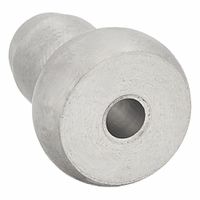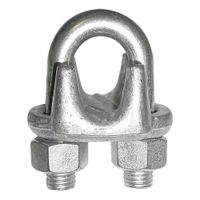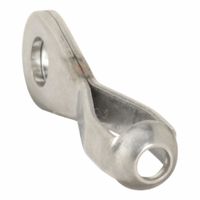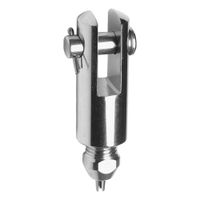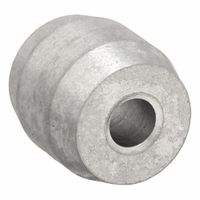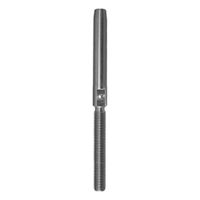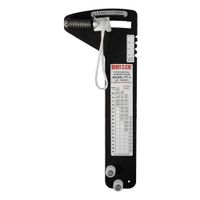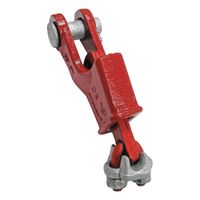Call +(254) 703 030 000 / 751 483 999 / 721 704 777
- Home
- Material Handling
- Lifting Pulling Positioning
- Wire Rope Fittings
- Fittings Accessories For Wire Rope
.....Read More
Frequently Asked Questions
What are the different types of wire rope fittings and accessories?
Wire rope fittings and accessories are essential for securing, connecting, and terminating wire ropes in various applications. Here are the main types:
1. **Wire Rope Clips**: Used to form a loop at the end of a wire rope. They consist of a U-bolt, a saddle, and nuts. Commonly used for temporary connections.
2. **Thimbles**: Inserted into the loop of a wire rope to prevent wear and deformation. They maintain the shape of the loop and protect the rope from abrasion.
3. **Turnbuckles**: Used to adjust the tension or length of wire ropes. They consist of two threaded eye bolts connected by a metal frame, allowing for precise tensioning.
4. **Swage Fittings**: Permanently attached to the wire rope using a swaging tool. They provide a strong, secure connection and are often used in rigging and lifting applications.
5. **Sockets**: Used to terminate wire ropes. Types include open spelter sockets, closed spelter sockets, and wedge sockets. They provide a strong, permanent connection.
6. **Eye Bolts and Eye Nuts**: Used for attaching wire ropes to structures or machinery. They provide a secure point for connecting ropes.
7. **Hooks**: Used for connecting wire ropes to loads. Types include clevis hooks, eye hooks, and swivel hooks, each designed for specific applications.
8. **Shackles**: Used to connect wire ropes to other components. Types include anchor shackles and chain shackles, available in various sizes and load capacities.
9. **Ferrules and Sleeves**: Used to create loops or terminate wire ropes. They are crimped onto the rope using a swaging tool, providing a secure connection.
10. **Load Binders**: Used to secure loads with wire ropes. They tighten the rope to ensure the load is stable during transport.
These fittings and accessories are crucial for ensuring the safety and effectiveness of wire rope systems in construction, marine, and industrial applications.
How do ball swage fittings enhance wire rope assemblies?
Ball swage fittings enhance wire rope assemblies by providing secure, efficient, and versatile terminations. These fittings are mechanically swaged onto the wire rope, creating a strong and permanent connection that can withstand high loads and stress. The swaging process compresses the fitting onto the rope, ensuring a tight grip that prevents slippage and maintains the integrity of the assembly.
Ball swage fittings are particularly advantageous due to their streamlined design, which minimizes bulk and allows for smooth passage through pulleys and other hardware. This design reduces wear and tear on both the wire rope and the fitting, extending the lifespan of the assembly. Additionally, the compact nature of ball swage fittings makes them ideal for applications where space is limited or where a clean, unobtrusive appearance is desired.
These fittings also offer versatility in application. They can be used in a variety of industries, including marine, construction, and aerospace, for tasks such as rigging, lifting, and securing loads. The ball end can be easily inserted into corresponding sockets or holes, facilitating quick and easy installation and removal. This feature is particularly useful in applications requiring frequent assembly and disassembly.
Furthermore, ball swage fittings contribute to safety by providing a reliable termination that reduces the risk of failure under load. The precision manufacturing of these fittings ensures consistent performance and compatibility with standardized components, enhancing the overall reliability of the wire rope assembly.
In summary, ball swage fittings enhance wire rope assemblies by offering strong, durable, and versatile terminations that improve performance, extend lifespan, and ensure safety across various applications.
What is the purpose of sleeves and thimbles in wire rope systems?
Sleeves and thimbles are essential components in wire rope systems, serving distinct but complementary purposes to ensure the integrity, safety, and longevity of the system.
Sleeves, also known as ferrules, are used to create secure terminations on wire ropes. They are typically made from materials like aluminum, copper, or steel and are applied by crimping or swaging. The primary purpose of sleeves is to form a strong, permanent loop at the end of a wire rope, which can then be attached to other components such as hooks, shackles, or other rigging hardware. This termination method is crucial for maintaining the load-bearing capacity of the wire rope and preventing slippage or unraveling under tension. Properly applied sleeves ensure that the wire rope can handle its rated load without failure, providing a reliable connection point in lifting, towing, or securing applications.
Thimbles, on the other hand, are used to protect the eye or loop of a wire rope. They are typically U-shaped metal fittings inserted into the loop to prevent the rope from bending excessively at the connection point. The purpose of thimbles is to maintain the shape and integrity of the loop, reducing wear and tear caused by friction and bending stresses. By providing a smooth, rounded surface for the rope to bear against, thimbles help distribute the load evenly and minimize the risk of kinking or crushing the rope fibers. This protection extends the life of the wire rope and enhances safety by reducing the likelihood of rope failure at critical points.
Together, sleeves and thimbles ensure that wire rope systems function effectively and safely, providing secure connections and protecting against premature wear and damage.
How do wedge sockets work in adjusting wire rope lengths?
Wedge sockets are mechanical devices used to secure and adjust the length of wire ropes. They consist of three main components: the socket body, the wedge, and the pin. The process of adjusting wire rope lengths using a wedge socket involves the following steps:
1. **Insertion**: The wire rope is threaded through the narrow end of the socket body, leaving a tail end that is typically about 20 times the diameter of the rope. This tail end is then bent back and inserted alongside the main line into the socket.
2. **Wedge Placement**: The wedge is inserted between the main line and the tail end of the wire rope within the socket body. The wedge is tapered, allowing it to fit snugly as it is driven into place.
3. **Securing**: As the wedge is driven further into the socket, it forces the wire rope against the walls of the socket body. This action creates a clamping effect, securing the rope in place. The friction and pressure between the wedge, the wire rope, and the socket body hold the rope firmly.
4. **Adjustment**: To adjust the length of the wire rope, the wedge can be removed by tapping it out, allowing the rope to be repositioned. Once the desired length is achieved, the wedge is reinserted and driven back into place to secure the new length.
5. **Load Application**: When a load is applied, the tension on the wire rope increases the clamping force, as the wedge is pulled tighter into the socket, enhancing the grip.
Wedge sockets are favored for their simplicity, ease of use, and ability to be quickly adjusted or released, making them ideal for applications requiring frequent length adjustments or quick disassembly.
What are wire rope clips used for?
Wire rope clips are used to secure the loose end of a wire rope after it has been looped back to form an eye. They are essential in various applications to ensure the stability and safety of wire rope assemblies. Commonly used in rigging, lifting, and hoisting operations, wire rope clips help in creating a temporary or permanent loop at the end of a wire rope, which can then be attached to hooks, shackles, or other lifting devices.
The clips consist of a U-bolt, a saddle, and two nuts. The U-bolt is placed over the wire rope, and the saddle is positioned underneath, with the nuts tightened to secure the assembly. This configuration ensures that the wire rope does not slip or unravel under tension.
Wire rope clips are used in industries such as construction, shipping, and mining, where they are crucial for tasks like securing loads, creating slings, and setting up guy lines. They are also used in recreational activities, such as setting up zip lines or securing cables in outdoor adventure parks.
Proper installation is critical for the effectiveness of wire rope clips. The number of clips required and the torque applied to the nuts depend on the diameter of the wire rope. Incorrect installation can lead to slippage or failure, posing safety risks. Therefore, following manufacturer guidelines and industry standards is essential to ensure the secure and reliable use of wire rope clips.
How do fork end fittings and eye fittings facilitate wire rope attachment?
Fork end fittings and eye fittings are essential components in wire rope assemblies, providing secure and reliable attachment points.
Fork end fittings, also known as clevis fittings, consist of a U-shaped end with a pin or bolt that passes through the fork and the component to which the wire rope is being attached. This design allows for easy connection and disconnection, making it ideal for applications requiring frequent adjustments or replacements. The fork end fitting provides a strong and stable connection, distributing the load evenly across the wire rope and minimizing stress concentrations that could lead to failure. It is commonly used in rigging, lifting, and structural applications where precise alignment and secure attachment are critical.
Eye fittings, on the other hand, feature a loop or eye at the end of the fitting, through which a shackle, hook, or other connecting hardware can be attached. This design offers a versatile and flexible connection point, allowing for a wide range of movement and adjustment. Eye fittings are often used in applications where the wire rope needs to be connected to a fixed point or where the connection must accommodate angular movement. The eye fitting provides a smooth and continuous surface for the wire rope, reducing wear and tear and extending the lifespan of the assembly.
Both fork end and eye fittings are typically made from high-strength materials such as stainless steel or galvanized steel, ensuring durability and resistance to corrosion. They are designed to meet specific load requirements and safety standards, making them suitable for various industrial, marine, and construction applications. By facilitating secure and efficient wire rope attachment, these fittings play a crucial role in ensuring the safety and reliability of wire rope systems.
Why are tension gauges important for wire rope systems?
Tension gauges are crucial for wire rope systems because they ensure safety, efficiency, and longevity. Wire ropes are used in various applications, such as cranes, elevators, and bridges, where precise tension is vital for optimal performance.
Firstly, tension gauges help maintain safety by preventing overloading. Excessive tension can lead to wire rope failure, posing significant risks to both equipment and personnel. By accurately measuring tension, gauges allow operators to adjust loads within safe limits, reducing the likelihood of accidents.
Secondly, tension gauges enhance operational efficiency. Proper tension ensures that wire ropes function smoothly, minimizing wear and tear. This leads to reduced maintenance costs and downtime, as well as improved performance in applications like lifting and hoisting.
Thirdly, tension gauges contribute to the longevity of wire rope systems. Consistent monitoring and adjustment of tension prevent premature wear and fatigue, extending the lifespan of the ropes. This is particularly important in industries where wire ropes are subject to constant use and harsh conditions.
Additionally, tension gauges facilitate compliance with industry standards and regulations. Many sectors have specific requirements for wire rope tension to ensure safety and reliability. Using tension gauges helps operators meet these standards, avoiding potential legal and financial repercussions.
In summary, tension gauges are essential for wire rope systems as they ensure safety, enhance efficiency, prolong system lifespan, and aid in regulatory compliance.
